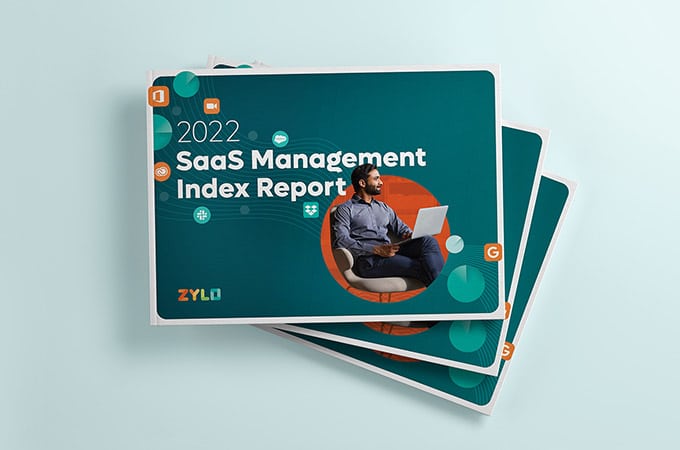
2022 Technology Trends Every CIO Needs to Pay Attention To
Table of Contents ToggleThe 2022 Technology Trends to Watch forTech Trend...
Back
Back
Search for Keywords...
Blog

Table of Contents
The pandemic forever changed the way we work, with many organizations permanently pivoting to virtual and hybrid work models.
It also significantly impacted how we think about the workplace. Perhaps Salesforce COO and President Bret Taylor said it best: “Work is not a place that you go to, it’s something you do.”
This new normal introduces the concept of the digital HQ, and makes clear the key role SaaS plays in powering the future of the workplace. Regardless if you work in a fully remote, hybrid, or in-person setting, SaaS remains at the core of how you stay connected, communicate, and conduct business.
IT teams spent the past two years responding to changes brought on by the pandemic. And they’ve implemented solutions to help organizations thrive during unprecedented times. It’s really no surprise we’ve seen the technology leadership role, notably the Chief Information Officer (CIO), gain prestige.
According to the digital magazine CIO, “With the pandemic accelerating digital transformation along with a shift to hybrid and remote work, the CIO profile has soared even higher, crystalizing the need for today’s IT leaders to be ambidextrous — as comfortable plotting a technology roadmap as they are discussing strategy in the boardroom.”
As we settle into the future of the workplace and strive toward digital maturity, we expect to see a new type of CIO leadership emerge to take on the unique set of challenges this “new normal” introduces.
According to CIO’s 2022 State of the CIO survey, “Eighty-six percent of respondents see the CIO role as more digital and innovation focused with 84% characterizing the CIO as a critical changemaker, taking the lead on business and technology transformation.”
Additionally, the survey says, “Seventy-nine percent of respondents expect the CIO to maintain a strong educational partnership with the CEO and board of directors.”
Today’s CIOs can level-up their role as a leader and innovator to drive success for the business and employees like never before. This progressive CIO of the future prioritizes:
This “Next CIO” also understands the importance of technology in driving the effectiveness of the organization, and actively pursues a partnership with the CFO to maximize value. They strive to make IT less of a cost center and more of a revenue generator by saving money and getting the most from SaaS investments. It’s a key reason why CEOs increasingly call CIOs the MVPs of the C-suite.
According to Kathryn Guarini, IBM CIO, “CIOs are helping drive innovation to break down silos across the organization and create new value streams. They serve as connectors across business functions and are engaging more with the CEO to develop technology strategies that drive agility and efficiency, and, ultimately, lead to business growth.”
After years of explosive growth, Bessemer Venture Partners predicts cloud software will account for a majority of all software by 2030. It means organizations need a new approach to managing software that encompasses both on-premise licenses as well as SaaS.
In order for CIOs to become the VIP at their organization, they’ll need SaaS. It is key to their success, enabling innovation and driving efficiencies and business results. To do that effectively, CIOs need to get their arms around their software estate.
In addition to this new phase of CIO leadership, we’re also seeing more organizations deploy dedicated SaaS managers. These individuals govern SaaS adoption and organization, and effectively manage and optimize existing systems for long-term success.
Under the guidance of progressive CIO leadership, IT teams will increasingly move out into the organization to better support and collaborate with business units—and finally make the shift from gatekeeper to true organizational enabler.
From increased employee automation and flexibility to exciting new roles in IT, discover more 2022 technology trends for CIOs and technology leaders.

Table of Contents ToggleThe 2022 Technology Trends to Watch forTech Trend...


See how the leader in cloud customer experience and contact center solutions reinforces software asset management and enterprise architecture with Zylo.

Table of Contents ToggleAdobe’s Core Learnings From Building Their SaaS Management...
| Cookie | Duration | Description |
|---|---|---|
| cookielawinfo-checkbox-analytics | 11 months | This cookie is set by GDPR Cookie Consent plugin. The cookie is used to store the user consent for the cookies in the category "Analytics". |
| cookielawinfo-checkbox-functional | 11 months | The cookie is set by GDPR cookie consent to record the user consent for the cookies in the category "Functional". |
| cookielawinfo-checkbox-necessary | 11 months | This cookie is set by GDPR Cookie Consent plugin. The cookies is used to store the user consent for the cookies in the category "Necessary". |
| cookielawinfo-checkbox-others | 11 months | This cookie is set by GDPR Cookie Consent plugin. The cookie is used to store the user consent for the cookies in the category "Other. |
| cookielawinfo-checkbox-performance | 11 months | This cookie is set by GDPR Cookie Consent plugin. The cookie is used to store the user consent for the cookies in the category "Performance". |
| viewed_cookie_policy | 11 months | The cookie is set by the GDPR Cookie Consent plugin and is used to store whether or not user has consented to the use of cookies. It does not store any personal data. |
